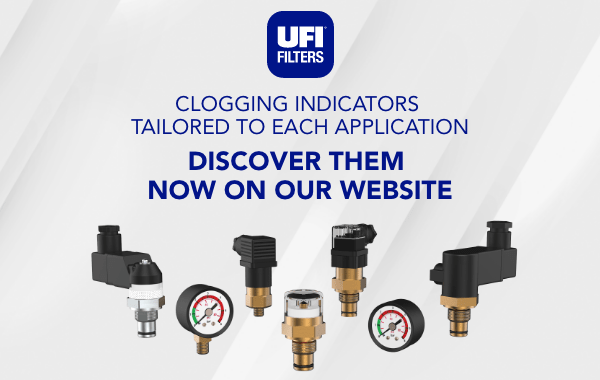
As we saw in last month’s article, contamination indicators for hydraulic applications are signaling devices that alert the operator when the filter element has reached its maximum degree of clogging and therefore needs to be replaced.
The device monitors the increase in pressure of the hydraulic fluid inside the filter due to the build-up of contaminants on the filter media.
When the indicator emits a signal, it means that the filter element needs to be replaced.
Types of pressure indicators
Depending on the application and the monitoring mode chosen to check the degree of clogging of the filter element, there are different types of clogging indicators, which can be classified according to certain technical characteristics:
Taking into account the way in which the information is transmitted by the sensor, the indicators can be divided into
- Visual indicators, which allow the pressure reached to be read directly on the sensor. Alternatively, in the electrical version, the sensor changes colour when the preset pressure level is reached.
- Electrical transmitters (pressure transmitters) are devices that convert the measured pressure into an electrical signal and allow continuous monitoring of the pressure level. When connected to the PLC, they can provide predictive analysis to optimise maintenance planning and ensure effective resource management.
- Electrical pressure indicators (pressure switches) are devices that open or close an electrical circuit when the pressure reaches a preset value. This allows an electrical signal to be transmitted, usually to the PLC, to warn when the filter element needs to be replaced.
If, on the other hand, we consider the pressure measurement mode, the indicators are divided into
- Absolute indicators
- Differential indicators
Absolute Gauges
They are called absolute because they measure a single (absolute) pressure value within the circuit.
The operation of an absolute indicator is simple but effective and consists of a pressure sensitive component connected to the filter.
The pressure is sensed on the dirty side of the filter, as this is the side where the pressure increases as the filter becomes clogged.
To use this indicator correctly, you need to know
- Pressure in the circuit
- The value of the pressure variation allowed inside the filter before the filter element is replaced.
With this information it is possible to calculate the absolute pressure that the indicator must reach in order to proceed with the maintenance.
This type of indicator is normally used for low pressure circuits.
There are several absolute pressure indicators in the UFI Hydraulics range:
- Analogue visual pressure indicators (pressure gauges)
- Electrical indicators (pressure switches)
Differential indicators
They are called differential because the output of the sensor is the value of the difference between 2 measured pressures.
To work, the indicator must measure the pressure at 2 points inside the filter, before and after the element.
This sensor directly measures the pressure delta determined by the element’s degree of clogging.
It is normally used in high pressure circuits.
There are several types of differential pressure indicators in the UFI Hydraulics range:
- Differential visual sensors, the sensor changes colour when the pressure value is reached.
- Electrical differential sensors
- Optical-electrical differential sensors
- Double setting differential sensors
Contamination indicators for vacuum applications
Suction applications, on the other hand, require the detection of pressure drops within a system in order to monitor when a certain vacuum level is reached.
The instruments used to monitor and control the vacuum in a system are vacuum gauges and vacuum switches.
Vacuum gauges, which are visual, provide a direct indication of vacuum pressure, allowing the operator to monitor the vacuum level in the system in real time and make any necessary adjustments to keep it stable and reliable.
Vacuum switches detect pressure changes within a system and, when a certain vacuum level is reached, activate control devices to alert the operator.
There are three main types
- with electrical contacts (SPST) NORMALLY OPEN (N.O.)
- with electrical contacts (SPST) NORMALLY CLOSED (N.C.)
- with electrical contacts in EXCHANGE (SPDT)
These devices are essential to ensure that the vacuum is kept within acceptable limits for the optimum operation of industrial equipment and processes.
Main advantages of contamination indicators
The main benefits of using a contamination indicator are
- Continuous and constant monitoring of the condition of the filter element, signalling the state of the filter’s efficiency;
- Optimisation of maintenance by indicating the best time to replace the filter element;
- Avoidance of contamination, thanks to the signal given before opening the bypass;
- Preventing downtime by providing early warning of critical element performance.
It is therefore important to select a contamination indicator that meets the specific needs of your application to ensure effective monitoring and reliable preventive maintenance.
To find the most suitable indicator for your system’s needs, browse UFI Filters Hydraulics’ extensive range of indicators or contact our sales team for personalised advice.